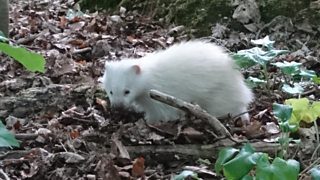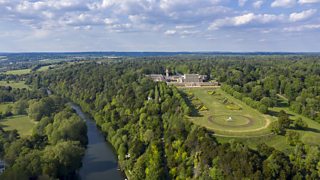An albino badger in Buckinghamshire: a story of wildlife amid human lockdown
National Trust
Partner organisation of the Watches
By Mark Bradshaw, General Manager at the National Trust’s Cliveden Estate
First it was orcas in Strangford Lough, then goats in Llandudno. Wildflowers sprung up in car parks and cuckoos were heard a stone’s throw from the M4... and here at Cliveden in Buckinghamshire, a rare albino badger turned up.
Not unlike a miniature polar bear in appearance, its bright white fur, caused by different genetics, stood out against the woodland floor as it rootled through leaves and twigs. True albino badgers are extremely rare, lacking any pigmentation and not to be confused with ‘erythristic’ badgers that lack black pigmentation and are more strawberry coloured.
It stuck around for 20 minutes, undeterred by the presence of one of our staff members who managed to capture a few seconds of footage. The badger has become somewhat of a local celebrity ever since.

Albino badger at Cliveden National Trust
Breathing space
Wildlife has been up to all kinds of things since us humans have been locked down. And it appears the National Trust’s empty gardens and estates have provided the perfect playground.
Over the past ten weeks, since closing our doors to help restrict the spread of coronavirus, the Trust’s outdoor staff have reported all kinds of unusual sightings and emboldened behaviour.
From peregrine falcons nesting in the ruins of Corfe Castle (for the first time since the 1980s) to a buzzard eating lunch in an orangery, animals and birds seem to be enjoying the breathing space. And while nature’s recovery is still a long way off, it has brought joy to many people to see nature thriving during these turbulent times.
But how do we build on this? How do we ensure nature still has room to thrive after this crisis is over? And how do we keep this increased appreciation of the natural world?

An aerial view of the Cliveden Estate in Buckinghamshire
Beyond the parterre
Cliveden might be better known for its majestic gardens and intriguing history but protecting and providing access to nature is a big part of what we do.
Beyond the formal gardens we take care of 375 acres of countryside which we manage for wildlife. We are conserving chalk grassland here and replanting trees in woodland areas.
Recently we’ve cleared an area of Spruce tree plantation that had poor species diversity. Letting in the light and re-planting with native broadleaf trees has transformed this area to become rich in wildlife enjoying the young trees and open ground flora. We’ve also ‘dead hedged’ along our woodland paths to protect trampling of the bluebells which can take over 5 years to re-flower from straying visitors. Clearing scrub is also necessary on areas of chalk grassland to help maintain the open grass sward for dependant insects. And the thousands of plants in our formal gardens provide tonnes of pollen for insects every year and when the plants die back, they’re all composted in our large compost yard to create wonderful nutrient rich soil to start the growing cycle all over again.
To mark its 125 years, and to address the catastrophic decline in UK wildlife and the climate crisis, the Trust has set itself big ambitions, including tree-planting on a national scale and reaching carbon net zero. I’m proud that Cliveden will be a part of that chapter.
Noticing nature
When we look back over these unprecedented times, I hope we’ll remember how we all stopped to notice nature more. Whether it was staring out of our windows at blossom trees, waking up to birdsong in the city, or as in my case, encountering a rare badger – the happiness and hope that nature brought us is something not to be forgotten.
